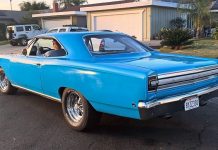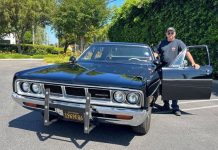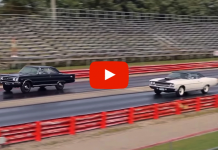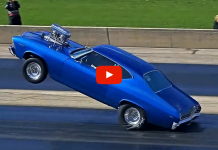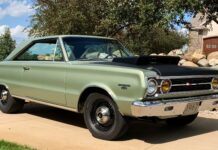Hey there, car lovers! If you're looking for some killer tips on selling a car, then this top 11 essential tips on selling a car article will help you make that successful sale. Buckle up and get ready for an informative ride!
We all know that selling your beloved ride can be a bit of a challenge. But with the right know-how and a little elbow grease, you'll be well on your way to finding a new home for your prized wheels. From knowing your car's true value to crafting an eye-catching ad, we've got you covered.
So, whether you're a seasoned car seller or just starting out, these tips are gonna give you the edge you need to make a smooth, profitable sale. Read on, my fellow motorheads, and let's get that car sold!
The Process of Selling Cars Has Undergone a Rapid Transformation in Recent Times!
The automotive industry is experiencing a significant shift towards the future, with car buyers increasingly preferring to initiate the purchasing journey online rather than spending excessive time at traditional dealerships. However, this begs the question: how can dealerships adapt to thrive in this digital era?
Gone are the days when print ads and billboards alone could ensure successful car sales. In today's landscape, simply offering attractive discounts is no longer sufficient.
With customers having easy access to detailed information about comparable vehicles within a 1,500-mile radius, even a competitive price cannot guarantee a sale. Used car sales tips and selling car advice can be useful in this changing scenario.
While having charisma and a friendly demeanour can certainly assist in selling vehicles, it's crucial to address the challenge of attracting customers to the dealership in the first place. Waiting passively for potential buyers to visit is no longer a viable strategy.
Instead, dealerships must proactively seek face-to-face interactions with customers before they set foot on the lot. Increasing marketing efforts and advertising becomes imperative to ensure that potential customers are aware of the dealership and its unique offerings.
Here Are the 11 Tips on Selling a Car to Improve Your Sales:
Tip #1: Learning and Remembering Your Customers' Names is Crucial.
As a car salesperson, your primary goal is to sell cars, and a person's name holds tremendous significance in achieving that goal. To enhance sales within your dealership, it is crucial for salespeople to receive proper training in learning and remembering names. This includes both existing and potential customers.
In today's world, personalized communication has become increasingly scarce. The authenticity of emails, text messages, and other marketing approaches has diminished. According to a survey conducted by Segment, personalized shopping experiences contribute to approximately 60% of customers becoming repeat buyers.
By incorporating a customer's name in communication and tailoring content to align with their interests, you create a remarkable first impression. Additionally, you can establish rapport and cultivate trust by ensuring customers feel valued rather than being treated as mere email addresses or phone numbers.
An adept car salesperson will strive to learn a customer's name immediately upon receiving an online lead. They will then utilize the customer's name in a video email introduction, fostering a casual and friendly tone. This is one of the essential selling your car online tips.
The mission here is to instil a sense of importance in the customer, build trust, encourage them to visit the showroom, and ultimately, guide them towards purchasing a car using car sales tips.
Tip #2: Unlock the Potential of Understanding Your Customers' Needs
To achieve successful car sales, it is crucial to identify and fulfil your customers' desires. This involves asking the right questions and practising active listening. Explore specific requirements such as:
- Identifying desired features.
- Considering financing options and credit constraints.
- Understanding the primary use of the vehicle, including factors like labour-intensive tasks and weekly mileage.
- Addressing any previous negative experiences that caused frustration and dissatisfaction.
The pandemic has led to a significant shift in customers conducting a substantial portion of their car-buying journey online. On average, they spend around 13-15 hours conducting research before stepping into the dealership. By asking pertinent questions like:
- "What brings you in today?"
- "What specific features are you seeking?"
- "Will you be the primary driver of this car?" You can gather valuable information about their preferences and ensure a tailored approach.
Armed with this knowledge, you can present alternative options that expand the range of cars available to them, which they might not have previously considered. These questions provide valuable context about the buyer's budget, preferences, and target audience.
Utilize their responses to cross-sell or upsell. For example, if safety is a priority for them, consider suggesting a four-wheel drive package or a pedestrian alert add-on.
Remember, it is essential to showcase the customer's dream car, along with other comparable options, even before they visit the dealership. How can this be accomplished? It's simple – send them personalized walk-around videos. This is a key component of a guide to selling your car.
Tip #3: Demonstrate Your Comprehensive Understanding of the Purchasing Process
Once you're introduced to potential customers, inquiries are bound to arise. Nowadays, individuals tend to resort to online searches rather than reaching out to you directly. Customers now possess greater knowledge due to the following factors:
- Access to nationwide vehicle inventories.
- Availability of detailed reports on various makes and models.
- Previous engagement with other dealerships and sales professionals via digital channels before contacting you.
However, it's solely in your hands to provide them with a complete picture throughout the car-buying journey, a task that Google cannot accomplish. To stand out in this levelled playing field, deliver direct responses to prospective clients' questions through personalized automotive video emails.
This approach allows you to create an exceptional car-buying experience. Avoid contradicting customers, as it may be perceived as condescension.
Tip #4: Avoid Providing False Information to Potential Buyers
It is essential to respond to customer inquiries with complete honesty. If you are unsure about an answer, inform the customer that you will investigate and provide accurate information later.
For example, imagine a customer notices a slightly misaligned door and some chipped paint on a car and asks about it. Instead of downplaying the issue and suggesting a fresh coat of paint would fix it, it is crucial to acknowledge any previous accidents and apologize for not mentioning it initially.
Deceptive responses should always be avoided, even if the customer remains unaware of the situation.
Transparency regarding the costs associated with purchasing the vehicle is crucial. These costs include processing fees, taxes, registration fees, licensing fees, and more. It is important to inform customers about these fees before they finalize the payment for the car.
The problem lies not in the existence of these fees, as every service has its price, but rather in surprising the customer with hidden fees at the last moment. Ensuring that customers are aware of all associated costs upfront helps build trust and avoids any unpleasant surprises.
Tip #5: Foster a Connection and Maintain Eye Contact
If you observe that the customer has become quiet or displays signs of discomfort, it's crucial to shift your focus from selling and prioritize building rapport. Persisting in overwhelming them with sales pitches or key selling points might lead to alienation and potential loss of the sale.
Instead, engage them in conversation by asking about their weekend activities, occupation, or place of origin. These non-threatening and easy-to-answer questions help create a relaxed atmosphere.
Once you notice their body language easing up, you can seamlessly transition back into the sales process by discussing their preferred car makes and models. This redirects the conversation towards the sale and avoids any potential hesitation.
When the prospect shares their thoughts, make sure to maintain eye contact, looking directly into their eyes while offering a warm and comforting smile. It is essential to make them feel comfortable and at ease.
If your demeanour puts them off, they might perceive a lack of interest in selling the vehicle to them, which could prompt them to walk away in a matter of seconds. Keep in mind that some individuals may struggle with eye contact, so it's important to be sensitive to their needs and maintain a soft gaze that doesn't make them feel uneasy.
Tip #6: Ensure That All Customers Are Treated With Equality and Fairness
Avoid making assumptions about potential clients when they visit the dealership. It's essential not to judge them based on their appearance or assume their financial capability.
Instead, make them feel involved in the decision-making process by asking relevant questions and attentively listening to their responses. Remember, everyone's opinions and preferences matter, irrespective of their attire or perceived wealth. By refraining from snap judgments, you create an inclusive environment.
Exercise patience with every customer, especially those who may be hesitant about financial decisions. However, it's important to be mindful of individuals who might distract you from more promising deals.
These individuals, often referred to as "tire kickers," don't align with the ideal customer profile. They may not research the solutions they need or possess the financial means to afford your offerings.
If you notice someone visiting the dealership repeatedly over the course of a week, test-driving multiple cars without committing to a purchase, it's a sign to be cautious and prioritize other potential buyers.
In addition to these tips, consider using the following advice when selling a used car privately or to a dealership. Use selling car-to-dealership tips and selling car-to-dealer tips to ensure a smooth transaction.
Tip #7: Avoid Speaking Negatively About Your Competitors
Refrain from engaging in negative discussions or criticism about rival dealerships.
Instead, shift your focus towards highlighting the unique qualities and strengths of your own dealership.
When a potential customer mentions receiving a better deal elsewhere, take a moment to gather your thoughts before responding. Emphasize the exceptional after-sales service your dealership offers, and your commitment to addressing their concerns, and even consider mentioning the option of an extended warranty.
When customers visit your dealership and express having received a superior offer from a competitor, maintain a positive approach.
- Rather than badmouthing the competition, concentrate on showcasing the distinguishing features of your dealership.
- Take the opportunity to inform customers about the unparalleled after-sales support they can expect, emphasizing your availability to address their needs promptly and efficiently.
- Additionally, consider offering an extended warranty as an added benefit, further highlighting the value your dealership brings to the table.
Tip #8: Tips on Selling a Car: Firm Pricing & Gentle Approach
Timing is crucial when initiating the sales pitch and discussing the price with a potential buyer. Wait for the right moment, such as when you sense their genuine interest in a particular car.
Asking them directly if they're ready to make the purchase today can be a good opener. Involving the sales manager in the conversation can facilitate negotiations, ensuring both the dealership's profitability and a fair deal for the buyer.
Steer clear of employing aggressive sales tactics that might put off customers. Rather than engaging in high-pressure selling, be transparent and upfront about the price. This approach helps eliminate tension and unnecessary haggling.
By disclosing the car's price from the outset, potential buyers can make an informed decision about whether to proceed with the purchase or explore other options. It's essential to communicate your willingness to accommodate reasonable negotiation but without setting an artificially high initial price.
Selling cars demands patience and a long-term perspective. Unlike selling everyday items, cars are significant investments that customers carefully consider. Paradoxically, people want to buy but don't want to feel forced into a sale. Avoid appearing desperate or overly pushy during the sales process.
Respect their need for time and space to evaluate their options. Encourage them to take their time, think it over, and make a decision that aligns with their needs. Sending a follow-up video expressing gratitude for their visit and emphasizing your commitment to their satisfaction helps nurture relationships and builds trust.
Remember, patience and perseverance are key to reaping the rewards of your efforts in the long run.
Tip #9: Avoid Discussing Payment Until the Price is Firmly Established
It's advisable to reserve price discussions for the final stages of the car-buying process. Only after confirming the customer's readiness to make a purchase should you delve into the topic of price.
At this point, payment options, cash down payments, and trade-in values can be considered. By waiting until the buyer has developed an emotional connection with the car and is committed to buying, you can involve your sales manager to negotiate a price that provides a fair deal for the buyer while maximizing profitability for your dealership.
One of the critical pitfalls to avoid is initiating a conversation about payment before discussing the price. As part of their training, car salespeople should be mindful never to initiate payment-related discussions first.
However, they should be attentive to the customer's budget and financing concerns, demonstrating sensitivity and addressing these aspects accordingly.
Tip #10: Ensure You Maintain Follow-Up Communication After Completing a Sale
Just because the customer has driven off with their new car doesn't mean your job is finished. Remember, the goal is to cultivate a long-term relationship with the customer, leading to repeat business and positive word-of-mouth for your dealership.
A key strategy for achieving success is to retain customers for life, either by encouraging their return or generating referrals. Take the opportunity to follow up with customers after the sale to inquire about their satisfaction with the vehicle.
Reach out within a week to address any potential issues they may be experiencing and provide suitable solutions. Additionally, invite them to share their feedback or testimonials on your website or social media platforms.
If feasible, kindly request them to refer friends and family to your dealership. Show your genuine appreciation for their business through personalized communication methods, such as a heartfelt video. These thoughtful gestures will leave a lasting impression.
Tip #11: Maintain a Strong Online Marketing Presence
With the significant shift in consumer behaviour towards online channels over the past couple of years, it's crucial for all dealerships to adapt and thrive in the digital landscape.
To stay ahead, prioritize online marketing initiatives that ensure clear and consistent messaging to attract potential customers. Engage your audience with captivating video content on various online platforms, such as social media.
Create videos showcasing your team and company culture, providing walkarounds of vehicles, highlighting giveaways and service centre specials, and offering valuable vehicle maintenance tips.
By establishing yourself as a trusted automotive expert, both existing and prospective customers will be more inclined to choose your dealership for their car purchase.
Capitalize on the gradually recovering economy by implementing strategies that drive customer traffic, increase vehicle sales, and ultimately boost your dealership's revenue.
Utilize the following pointers as a foundation and customize them to suit your specific needs. By leveraging these strategies effectively, you'll witness a noticeable rise in sales and overall business success.
Understanding the Car Selling Process
When it comes to professional car sales training, there exists a systematic process comprising essential steps that form the backbone of successful car salespeople. Each of these steps plays a vital role in determining your level of achievement in the field.
It is crucial to understand and master each of these elements to pave the way for your ultimate success in the realm of car sales.
Process #1: Car Sales Meet and Greet
During the car sales meet and greet, it is crucial to make a lasting first impression. Your appearance speaks volumes before any words are exchanged. Ensure that your clothes are clean, pressed, and professional, avoiding the look of just rolling out of bed or finishing a run.
Shine your shoes and tuck in your shirt or blouse, displaying a well-groomed appearance. A genuine smile and enthusiastic facial expression will convey your eagerness to assist the customer.
Avoid frowns, phoney smiles, or chewing gum during this critical interaction. Remember, the car sales meet and greet sets the stage for successful customer interaction, so pay attention to these details to make a positive impact.
Process #2: Discovery and Determine Needs
During the initial meet and greet, it's crucial to quickly discover and determine the customer's needs. This involves understanding their preferences, whether they're looking for a car, truck, or SUV, and any specific options that are important to them.
By attentively listening to their desires, you can identify the model they are interested in and arrange a test drive.
While many dealerships provide scripts or word tracks to guide their sales staff in determining needs, it's essential to prioritize the customer's input. These scripts often include questions about their current vehicle and the type of vehicle they wish to replace it with.
While these questions are useful, it's advisable to avoid discussions about trade-ins, credit, financing, price, or current payments at this stage. If the customer raises these topics, address them cautiously, considering the impact of your responses.
Process #3: Car Sales Walk-Around
During the crucial car sales walk-around, it's essential to educate the buyer and ignite their excitement about the chosen vehicle. Often overlooked and poorly executed, this step aims to reinforce their decision and cultivate an irresistible desire to own the car.
As part of the walk-around process, it's important to acknowledge their selection and highlight the vehicle's accomplishments or accolades.
For instance, you can mention that the chosen model has been the best-selling sedan for five consecutive years or that it's a top pick according to Kelly Blue Book. By sharing relevant facts and awards, you not only compliment the buyer but also provide reassurance that they've made a wise choice in selecting the vehicle.
Process #4: A Car Selling Test Drive
When it comes to customer test drives during the car-selling process, dealerships vary in their approaches. While some dealers simply hand over the keys and let the customer take the wheel, most modern dealerships prefer having a car salesman accompany the customer on the test drive.
Personally, I believe that going on the test drive together is crucial as it not only allows for effective selling but also provides an opportunity to gauge the customer's level of interest, making it a vital step in the overall car sales process.
Process #5: Post-Test Drive Discovery
Post-Test Drive Discovery is a crucial part of the car-selling process. It begins after the test drive when the customer brings the prospective vehicle back to the dealership. To maintain focus on this critical step, it is essential to separate it from the actual test drive.
Once the car is parked, it's important to guide the customer to a designated area away from other vehicles. This ensures that they don't get distracted or second-guess their choice. Before exiting the car, it's time to ask some questions to evaluate if the right car has been chosen and if it's appropriate to proceed to the next stage.
Process #6: Car Sales Negotiating or Discussion
When it comes to the car-selling process, one crucial aspect is the negotiation or discussion phase. It's essential to have a clear and definite selection of the car you're selling, without any doubts or settling for alternatives.
The customer must be fully committed to the chosen car, as negotiations won't progress smoothly otherwise. This emphasizes the significance of solid selection before entering into any negotiation for a car sale.
Process #7: Closing the Car Sale – Make a Deal
Closing the car sale is a crucial step that encompasses the art of negotiation and instilling confidence in the buyer. It starts from the very first interaction and extends throughout the entire process.
To successfully close the sale, you must convince the customer about your credibility, the dealership's reliability, and the suitability of the car. Building trust and ensuring the buyer feels confident in their decision to invest a significant amount of money is paramount.
The transaction's success hinges on the customer's comfort level with you, the dealership, and, of course, the chosen car.
Process #8: F&I or Business Office – Finance and Paperwork
When the car sale is closed, your customer will proceed to the business office, also known as F&I (Finance and Insurance), where the necessary paperwork will be completed and the car sale will be finalized.
This step is common in most car dealerships, and it is important to prepare your customer for what to expect next. By ensuring a smooth and pleasant transaction, you can prevent any potential doubts or hesitations that may jeopardize the deal.
Start by explaining the process to your customer, beginning with the business office where the documents will be prepared by the F&I manager, who may also present additional product offerings. Finally, highlight that the last step is the delivery process, emphasizing that the customer is on track for a successful car purchase.
Process #9: First Class Car Sales Delivery-Delivering the Sold Car
The car delivery is the final step in the car-selling process, and it's crucial to make it smooth, easy, and memorable for the customer. As they are eager to hit the road in their newly purchased vehicle, it's essential to provide a first-class experience that will leave a lasting impression and result in a positive CSI survey.
To ensure a seamless delivery, have the car fueled and cleaned while the customer is in the Business Office, as this allows you to conduct a thorough inspection beforehand. Take the time to perform a walk-around of the vehicle, checking for any scratches or damage. Additionally, ensure that both the interior and exterior of the car are spotlessly clean.
A flawless delivery can be tarnished by the customer discovering a scratch or encountering a dirty seat, so attention to detail is key in providing an exceptional experience.
Process #10: After the Sale – Sold, No Sale or Review
After the sale, there are two possible outcomes to consider: either the customer has successfully purchased the car and taken delivery, or they have decided not to proceed with the purchase.
In the former case, it is important to ensure a smooth transition for the customer by providing any necessary documentation, explaining the warranty and maintenance details, and addressing any remaining questions or concerns they may have.
It is also an opportune time to express gratitude for their business and encourage them to leave a positive review or provide feedback about their experience. On the other hand, if the customer left without buying a car, it is crucial to evaluate the interaction and identify any potential areas for improvement.
This may involve reviewing sales techniques, addressing any issues or objections raised by the customer, and seeking ways to enhance the overall sales process for future opportunities.
Determining Your Car's Value
The best way to determine a car's worth is by using valuation guides like Kelley Blue Book and looking at live prices online and at dealerships. It’s vital to know a car's value before you start any transaction to sell, trade-in, buy or refinance a vehicle. Here are the steps to getting an accurate car value:
1. Utilize Car Value Guides
When it comes to finding the accurate value of your car, tapping into online car price guides is a smart move. These handy tools allow you to input your car's details and location, presenting you with a comprehensive range of its estimated worth.
Here are three esteemed car value guides that are widely recognized in the industry:
- Kelley Blue Book (KBB): As the oldest car value guide, Kelley Blue Book has been a trusted source for years, offering comprehensive insights.
- NADAguides: Representing franchised dealers, the National Automobile Dealers Association (NADA) provides consumers access to its retail valuation guide, ensuring reliable estimates.
- Edmunds: The youngest of the trio, Edmunds' True Market Value tool provides transparent information on whether a car is priced appropriately.
It's worth noting that inputting the same vehicle details into all three guides may yield slightly varying results. If you're selling your car, it's advisable to highlight the highest value obtained, while buyers should consider referencing the lowest value to ensure a fair deal.
2. Choose the Desired Value Category
The value of a car ultimately depends on the willingness of a potential buyer to pay for it. However, with numerous individuals and an extensive range of vehicles out there, it becomes essential to determine the specific category of value you wish to consider.
If you intend to sell your car:
- Trade-in value. This represents the amount a dealer would typically offer for your vehicle. It tends to be the lowest value since opting to trade your car at a dealership is a more convenient option compared to selling it directly to another individual.
- Private seller value. If you're willing to put in the effort to sell your car through platforms like Craigslist, you can typically fetch a few thousand dollars more in exchange for the additional work involved.
Remember, choosing the appropriate value category can greatly impact your selling experience and the final price you receive for your car.
3. Assess the Value Based on the Car's Overall Condition
The value of a car can be significantly influenced by its condition, which spans a spectrum from fair to excellent. This evaluation takes into account various factors such as the health of the engine and the presence or absence of cosmetic issues.
As stated by Kelley Blue Book, a majority of used cars are typically categorized as being in "good" condition. This implies that the vehicle may have some reparable cosmetic defects but is devoid of major and costly mechanical problems.
4. Gather Real-Time Examples
Examine the current prices of similar vehicles by referring to dealer advertisements, Craigslist listings, and popular car-buying websites. These valuable resources provide live examples that can assist you in gauging the true value of your car.
By analyzing the asking prices of comparable vehicles in the market, you can gain a better understanding of where your car stands.
Additionally, you have the option of obtaining an offer directly from a car company. This can be done either in person at a dealership or conveniently online. Approaching the source itself allows you to receive a personalized valuation based on the specific details of your car, ensuring a more accurate estimation of its worth.
Remember, by seeking out real-time examples and utilizing reliable sources, you can confidently determine the value of your car and make informed decisions during the selling process.
5. Examine Your Needs
To accurately determine your car's value, it is crucial to assess your specific requirements and circumstances. Take into account the following factors:
Consider Your Financial Goals
Determine the amount you aim to receive for your vehicle and establish your budget for purchasing a new car. If maximizing your vehicle's value or minimizing expenses is a priority, consider engaging directly with individuals rather than involving a dealership.
Assess Transaction Speed
Evaluate how quickly you desire to complete the transaction. If immediate cash is your primary objective, selling your vehicle to a car company or dealership may be the fastest option. However, selling it independently could potentially yield a higher financial return, albeit requiring more time and effort.
Evaluate Time and Effort
Gauge the amount of energy and time you can dedicate to the selling or buying process. While bypassing the dealership may result in cost savings or additional earnings, it typically involves active involvement.
Selling directly to individuals entails tasks such as communicating with potential buyers, advertising your car, conducting test drives, and handling paperwork at the local DMV. Similarly, purchasing directly from other individuals involves meeting strangers for test drives.
By carefully considering these factors, you can make an informed decision that aligns with your financial goals, time constraints, and personal preferences.
Cruisin' to Success: Tips on Selling a Car — Seal the Deal!
Armed with these powerful tips on selling a car, you're all set to hit the road to a successful sale! These eleven essential tips will not only help you attract the right buyers but also make sure you get the best bang for your buck. Keep your ride lookin' sharp, set a competitive price, and show off your car's best features to reel in those eager buyers.
Always remember, knowledge is power when it comes to selling your beloved car. By being well-prepared, understanding the market, and having all the right documents in place, you'll be in the driver's seat throughout the entire selling process.
So, buckle up, and get ready to steer your way to a smooth and rewarding sale with these incredible tips on selling a car. Good luck, and happy selling!









